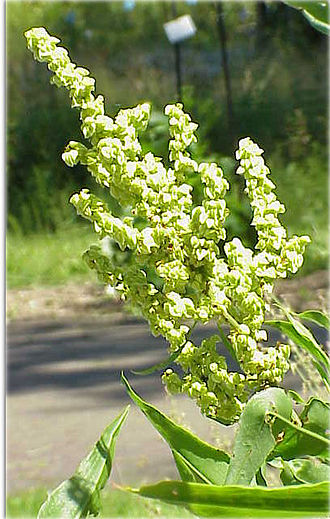Translations:AY Honors/Agriculture/Answer Key/21/en
From Pathfinder Wiki
Rumex
| Rumex (Dock) | |
|---|---|
|
Where found: Members of this family are very common perennial herbs growing in acidic, sour soils mainly in the northern hemisphere, but have been introduced almost everywhere.
Description: These are erect plants with long tap roots. The fleshy to leathery leaves form a basal rosette at the root. The basal leaves may be different from those near the inflorescence. They may or may not have stipules. There are minor leaf veins. The leaf blade margins are entire or crenate.
Control: Keeping fields well drained will help control dock. Young plants may be controlled by cultivation, but because mature plants send tap roots deep into the soil, it is difficult to eradicate them this way. Chemical controls include applying a combination of glyphosate and dicamba via a wiper when the plants are at least 30cm higher than the crops in which they grow.
|
 |
Taraxacum
| Taraxacum (Dandelion) | |
|---|---|
|
Where found: Dandelions are native to Africa, Asia and Europe, and have been widely introduced elsewhere. Dandelions have become established in the Americas, Australia and New Zealand and are now common throughout all temperate regions.
Description: The leaves are 5-25 cm long, simple and basal, entire or lobed, forming a rosette above the central taproot. As the leaves grow outward they push down the surrounding vegetation, such as grass in a lawn, which kills other plants by cutting off their access to sunlight. A bright yellow flower head (which is open in the daytime but closes at night) is borne singly on a hollow stem (scape) which rises 4-30 cm above the leaves and exudes a milky sap (latex) when broken. A rosette may produce several flowering stems at a time. The flower head is 2-5 cm in diameter and consists entirely of ray florets. The flower head matures into a spherical "clock" containing many single-seeded fruits (achenes). Each achene is attached to a pappus of fine hairs, which enable wind-dispersal over long distances.
Control: Dandelion seeds are windborne, so it is difficult to prevent an infestation. If possible, dig the plants up at the edge of a field before they produce seeds. Otherwise, chemical controls may be necessary. Glyphosate, mecoprop, and other herbicides can be applied to young plants. 2, 4-D is effective against established infestations.
|
 |
